10 Extending the Domain to Include Oracle WebCenter Content
This chapter describes how to extend a domain to include Oracle WebCenter Content using the Oracle Fusion Middleware Configuration Wizard. It contains the following sections:
-
Section 10.1, "Overview of Extending the Domain to Include Oracle WebCenter Content"
-
Section 10.3, "Starting Node Manager on WCCHOST1 and WCCHOST2"
-
Section 10.4, "Propagating the Domain Configuration to the Managed Server Domain Directories"
-
Section 10.6, "Starting the WLS_WCC1 Managed Server and Configuring Content Server"
-
Section 10.7, "Updating the cwallet File in the Administration Server"
-
Section 10.8, "Starting the WLS_WCC2 Managed Server and Configuring Content Server"
-
Section 10.9, "Validating GridLink Data Sources for WebCenter Content"
-
Section 10.11, "Configuring Service Retries for Oracle WebCenter Content"
-
Section 10.12, "Configuring Oracle HTTP Server for the WLS_WCC Managed Servers"
-
Section 10.13, "Validating Access Through the Load Balancer"
-
Section 10.14, "Configuring Node Manager for the WLS_WCC and WLS_IMG Managed Servers"
Note:
Before starting the setup process, read the Oracle Fusion Middleware Release Notes for your platform for additional installation and deployment information.
10.1 Overview of Extending the Domain to Include Oracle WebCenter Content
The Oracle WebCenter Content system is installed using the WL_HOME and ORACLE_HOME locations created in Chapter 6, "Installing the Software for an Enterprise Deployment," on a shared storage. WCCHOST1 and WCCHOST2 mount MW_HOME and reuse the existing Oracle WebLogic Server, Oracle SOA Suite, and Oracle WebCenter Content binary installations. The pack and unpack utilities are used to bootstrap the domain configuration for the WLS_WCC1 and WLS_WCC2 servers in these two new nodes. As a result, you do not need to install any software in these two nodes.
For the Oracle WebCenter Content system to work properly, WCCHOST1 and WCCHOST2 must maintain the same system requirements and configuration that was required for installing Oracle Fusion Middleware in SOAHOST1 and SOAHOST2. Otherwise, unpredictable behavior in the execution of binaries may occur.
Note:
You will have already added Oracle SOA Suite components to the domain, as described in Section 9, "Extending the Domain to Include Oracle SOA Suite Components."
Extend the domain to include Oracle WebCenter Content. Table 10-1 lists the steps for configuring WebCenter Content and other tasks required for extending the domain with WebCenter Content Managed Servers.
Table 10-1 Steps for Extending the Domain with WebCenter Content
| Step | Description | More Information |
|---|---|---|
|
Extend the domain for WebCenter Content |
Extend the WebLogic Server domain you created in Chapter 8, "Creating a Domain for an Enterprise Deployment," to include Oracle WebCenter Content. |
|
|
Start Node Manager on the WebCenter Content Managed Servers |
Run the setNMProps.sh script and then start Node Manager on WCCHOST1 and on WCCHOST2. |
Section 10.3, "Starting Node Manager on WCCHOST1 and WCCHOST2" |
|
Propagate the domain configuration to the WebCenter Content Managed Servers |
Propagate the start scripts and classpath configuration from the Administration Server's domain directory to the Managed Server domain directories. |
Section 10.4, "Propagating the Domain Configuration to the Managed Server Domain Directories" |
|
Restart the Administration Server for the domain |
Stop and then restart the Administration Server. |
|
|
Start the first WebCenter Content Managed Server and configure its Content Server instance |
Start the WLS_WCC1 Managed Server and complete the initial Content Server configuration. |
Section 10.6, "Starting the WLS_WCC1 Managed Server and Configuring Content Server" |
|
Propagate the changes in the cwallet.sso file back to the Administration Server. |
Copy the updated cwallet.sso file to the Administration Server directory. |
Section 10.7, "Updating the cwallet File in the Administration Server" |
|
Start the second WebCenter Content Managed Server and configure its Content Server instance |
Configure the WLS_WCC2 Managed Server and complete the initial Content Server configuration. |
Section 10.8, "Starting the WLS_WCC2 Managed Server and Configuring Content Server" |
|
Verify the configuration of GridLink data sources and Oracle Notification Service (ONS) |
Follow these instructions to verify that the configuration of GridLink data sources and ONS is correct. |
Section 10.9, "Validating GridLink Data Sources for WebCenter Content" |
|
Configure parameters for cluster nodes |
Add directory locations for WebCenter Content trace and event logs, as needed. |
|
|
Enable service retries after an Oracle RAC failover |
Set the ServiceAllowRetry configuration parameter to |
Section 10.11, "Configuring Service Retries for Oracle WebCenter Content" |
|
Configure Oracle HTTP Server with the extended domain |
Configure the Oracle HTTP Server with the Managed Servers, set the front-end HTTP host and port, and set the WebLogic Server cluster address for WCC_Cluster. |
Section 10.12, "Configuring Oracle HTTP Server for the WLS_WCC Managed Servers" |
|
Validate access to WebCenter Content through Oracle HTTP Server |
Verify the URLs to ensure that appropriate routing and failover is working from Oracle HTTP Server to WCC_Cluster. |
Section 10.13, "Validating Access Through the Load Balancer" |
|
Configure host name verification for the communication between Node Manager and the Managed Servers in the domain |
Use certificates for the different addresses communicating with the Administration Server and other servers. |
Section 10.14, "Configuring Node Manager for the WLS_WCC and WLS_IMG Managed Servers" |
|
Back Up the WebCenter Content Configuration |
Back up the newly extended domain configuration. |
10.2 Extending the Domain for WebCenter Content
You can extend the domain created in Section 8, "Creating a Domain for an Enterprise Deployment" to include Oracle WebCenter Content. The instructions in this section assume that the Oracle WebCenter Content deployment uses the same database service as the Oracle SOA Suite deployment (wccedg.mycompany.com).
Note:
Before performing these steps, back up the domain as described in the Oracle Fusion Middleware Administrator's Guide.
To extend the domain for Oracle WebCenter Content:
-
Make sure that the database where you installed the repository is running.
For Oracle RAC databases, it is recommended that all instances are running, so that the validation check later on becomes more reliable.
-
On SOAHOST1, change the directory to the location of the Oracle Fusion Middleware Configuration Wizard. This is within the Oracle Common home directory (domain extensions are run from the node where the Administration Server resides).
cd ORACLE_COMMON_HOME/common/bin -
Start the Fusion Middleware Configuration Wizard:
./config.sh
-
In the Welcome screen, select Extend an existing WebLogic domain, and click Next.
-
In the Select a WebLogic Domain Directory screen, select the WebLogic Server domain directory (
ORACLE_BASE/admin/domain_name/aserver/domain_name), and click Next. -
In the Select Extension Source screen (Figure 10-1), make these selections:
-
Select Extend my domain automatically to support the following added products.
-
Select this product:
Oracle Universal Content Management - Content Server - 11.1.1.0 [wcc]
This is the selection for Oracle WebCenter Content.
Figure 10-1 Select Extension Source Screen for Oracle WebCenter Content
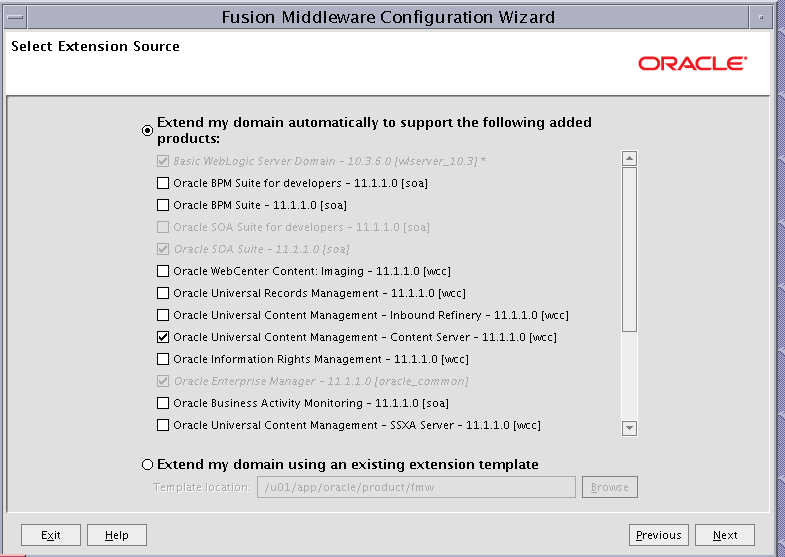
Description of "Figure 10-1 Select Extension Source Screen for Oracle WebCenter Content"
The following products should already be selected and grayed out. They were selected when you created the domain (Section 8.3) or extended it for Oracle SOA Suite components (Section 9.3).
Basic WebLogic Server Domain - 10.3.6.0 [wlserver_10.3]
Oracle SOA Suite for developers - 11.1.1.0 [soa]
Oracle SOA Suite - 11.1.1.0 [soa]
Oracle Enterprise Manager - 11.1.1.0 [oracle_common]
Oracle WSM Policy Manager - 11.1.1.0 [oracle_common]
Oracle JRF - 11.1.1.0 [oracle_common]
Click Next.
-
-
In the Configure JDBC Component Schema screen (Figure 10-2), do the following:
-
Select UCM Schema (for WebCenter Content). Do not select any of the other existing schemas.
Figure 10-2 Configure JDBC Component Schema Screen for Oracle WebCenter Content
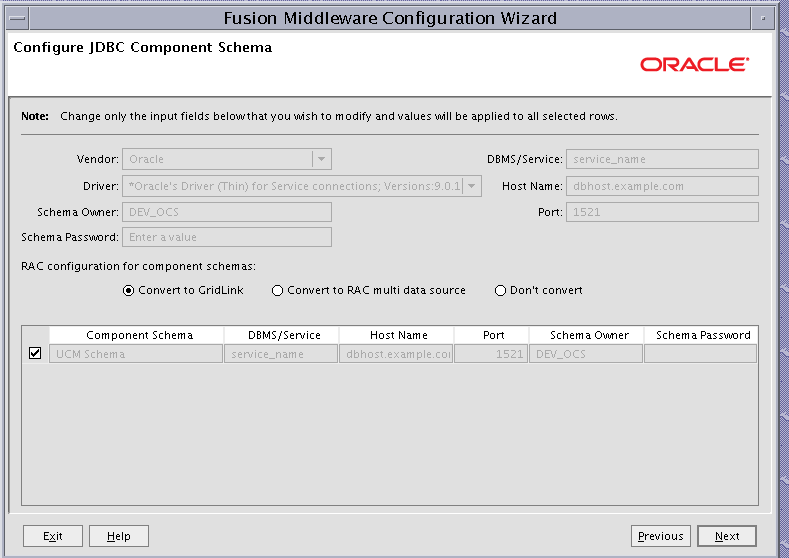
Description of "Figure 10-2 Configure JDBC Component Schema Screen for Oracle WebCenter Content"
-
For the RAC configuration, you can select Convert to GridLink or Convert to RAC multi data source (described in Appendix A, "Using Multi Data Sources with Oracle RAC"). For the instructions given here, select Convert to GridLink.
After you select a RAC configuration, all selected schemas are grayed.
-
Click Next.
-
-
In the Configure GridLink RAC Component Schema screen (Figure 10-3), do the following:
-
Select UCM Schema (for WebCenter Content). Leave the other data sources as they are.
Figure 10-3 Configure GridLink RAC Component Schema Screen for WebCenter Content

Description of "Figure 10-3 Configure GridLink RAC Component Schema Screen for WebCenter Content"
-
Enter values for the following fields, specifying the connection information for the GridLink RAC database that was seeded through RCU:
-
Driver: Select Oracle driver (Thin) for GridLinkConnections; Versions:10 and later.
-
Service Name: Enter the service name of the Oracle RAC database in lowercase letters, followed by the domain name; for example,
wccedg.mycompany.com. -
Username: Enter the complete user name for the database schema owner of the corresponding component.
This book uses
DEVas the prefix of user names for the database schemas. -
Password: Enter the password for the database schema owner.
-
Select Enable FAN.
-
Enable SSL: Leave this option deselected.
If you select SSL to enable Oracle Notification Service (ONS) notification encryption, provide the appropriate Wallet File and Wallet Password details.
-
Service listener: Enter the Oracle Single Client Access Name (SCAN) address and port for the Oracle RAC database being used. The protocol should be
TCP.Oracle recommends that you use a SCAN address to specify the Service Listener (and OSN Host) so you do not need to update a GridLink data source containing a SCAN address if you add or remove Oracle RAC nodes. To determine the SCAN address, query the
remote_listenerparameter in the database:SQL>show parameter remote_listener; NAME TYPE VALUE ----- ------ ------- remote_listener string db-scan.mycompany.com:1521
Note:
For Oracle Database 11g Release 1 (11.1), use the virtual IP and port of each database instance listener; for example:
custdbhost1-vip.mycompany.com (port 1521)
and
custdbhost2-vip.mycompany.com (1521)
For Oracle Database 10g, use multi data sources to connect to an Oracle RAC database. For information about configuring multi data sources, see Appendix A, "Using Multi Data Sources with Oracle RAC."
-
ONS Host: Enter here also the SCAN address for the RAC database and the ONS remote port, as reported by the database:
[orcl@CUSTDBHOST2~]$ srvctl config nodeapps -s ONS exists: Local port 6100, remote port 6200, EM port 2016
Note:
For Oracle Database 11g Release 1 (11.1), use the host name and port of each database's ONS service; for example:
custdbhost1.mycompany.com (port 6200)
and
custdbhost2.mycompany.com (6200)
-
-
Click Next.
Note:
Leave the SOA Infrastructure, User Messaging Service, OWSM MDS Schema, and SOA MDS Schema information as is.
-
-
In the Test JDBC Component Schema screen (Figure 10-4), select the UCM Schema row, then click Test Connections.
The Connection Results Log displays the results. Ensure that the connection to the database that contains the schema was successful. If not, click Previous to return to the previous screen, correct your entry, and then retry the test.
Figure 10-4 Test JDBC Component Schema Screen for WebCenter Content

Description of "Figure 10-4 Test JDBC Component Schema Screen for WebCenter Content"
Click Next when the connection is successful.
-
In the Optional Configuration screen, select the following options:
-
Managed Servers, Clusters and Machines
-
Deployment and Services
Click Next.
-
-
In the Configure Managed Servers screen (Figure 10-5), add the required Managed Servers.
Figure 10-5 Configure Managed Servers for WebCenter Content
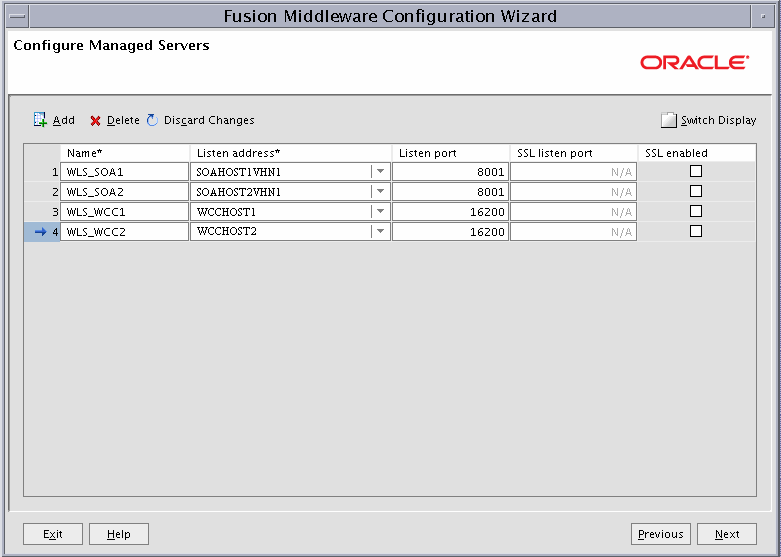
Description of "Figure 10-5 Configure Managed Servers for WebCenter Content"
A server is created automatically. Rename this server to WLS_WCC1 and add a new server called WLS_WCC2. Give these servers the attributes listed in Table 10-2. Do not modify the other servers that are shown in this screen; leave them as they are.
Name Listen Address Listen Port SSL Listen Port SSL Enabled WLS_WCC1
WCCHOST1
16200
n/a
No
WLS_WCC2
WCCHOST2
16200
n/a
No
Click Next.
-
In the Configure Clusters screen (Figure 10-6, click Add to add the clusters as shown in Table 10-3. Do not modify the other clusters that appear in this screen; leave them as they are.
Name Cluster Messaging Mode Multicast Address Multicast Port Cluster Address WCC_Cluster
unicast
n/a
n/a
Leave empty
Figure 10-6 Configure Clusters Screen for WebCenter Content
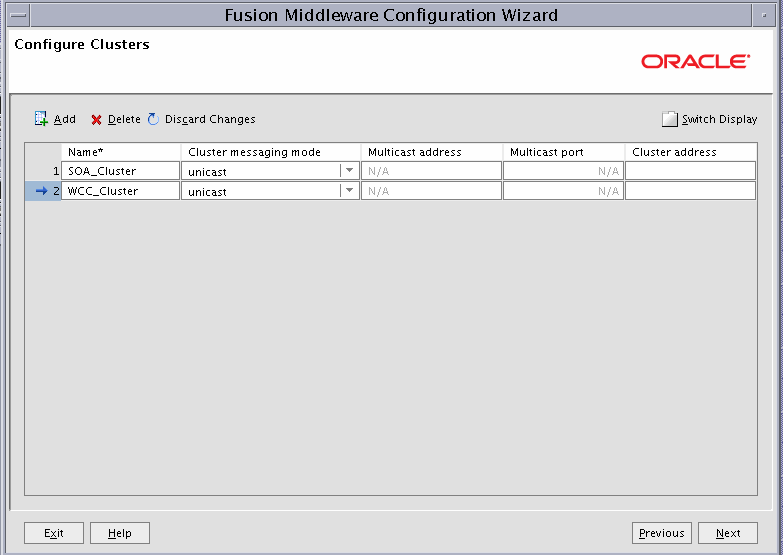
Description of "Figure 10-6 Configure Clusters Screen for WebCenter Content"
Click Next.
-
In the Assign Servers to Clusters screen, add the following. Do not modify the other assignments that appear in this screen; leave them as they are.
-
WCC_Cluster:
-
WLS_WCC1
-
WLS_WCC2
-
Click Next.
-
-
In the Configure Machines screen (Figure 10-7), open the Unix Machine tab and add the following two new machines:
Leave all other fields set to their default values.
Click Next.
-
In the Assign Servers to Machines screen (Figure 10-8), assign servers to machines as follows:
-
Assign WLS_WCC1 to WCCHOST1.
-
Assign WLS_WCC2 to WCCHOST2.
Figure 10-8 Assign Server to Machines Screen for WebCenter Content

Description of "Figure 10-8 Assign Server to Machines Screen for WebCenter Content"
Click Next.
-
-
In the Target Deployments to Clusters or Servers screen, make sure that the DMS Application is targeted to the SOA_Cluster, WCC_Cluster, and Admin Server. Click Next.
-
In the Target Services to Clusters or Servers screen, click Next.
-
In the Configuration Summary screen, click Extend.
-
If you see a warning dialog about port conflicts for the domain, click OK.
-
In the Creating Domain screen, click Done.
-
Restart the Administration Server to make these changes to take effect.
To restart the Administration Server, stop it first using the Administration Console and then start it again as described in Section 8.4.3, "Starting the Administration Server on SOAHOST1."
10.3 Starting Node Manager on WCCHOST1 and WCCHOST2
To start Node Manager on WCCHOST1 and WCCHOST2 if Node Manager has not started already:
-
On both WCCHOST1 and WCCHOST2, run the setNMProps.sh script, which is located in the ORACLE_COMMON_HOME
/common/bin/directory, to set theStartScriptEnabledproperty totruebefore starting Node Manager:cd ORACLE_COMMON_HOME/common/bin ./setNMProps.shNote:
You must use the
StartScriptEnabledproperty to avoid class loading failures and other problems. See also Section 16.12.3, "Incomplete Policy Migration After Failed Restart of SOA Server."Note:
If the WebCenter Content server is sharing the Middleware home in a local or shared storage with Oracle SOA Suite, as suggested in the configuration described in Chapter 3, "Preparing the Network for an Enterprise Deployment" it is not required to run setNMProps.sh again. In this case, Node Manager has already been configured to use a start script.
-
Run the following commands on both WCCHOST1 and WCCHOST2 to start Node Manager:
cd WL_HOME/server/bin ./startNodeManager.sh
10.4 Propagating the Domain Configuration to the Managed Server Domain Directories
To propagate the domain configuration:
-
Run the
packcommand on SOAHOST1 to create a template pack, using the following commands:cd ORACLE_COMMON_HOME/common/bin ./pack.sh -managed=true -domain=ORACLE_BASE/admin/domain_name/aserver/domain_name -template=edgdomaintemplateWCC.jar -template_name=edgdomain_templateWCC
-
Run the following command on SOAHOST1 to copy the template pack created in the previous step to WCCHOST2:
Note:
Assuming that WCCHOST1 shares the ORACLE_HOME with SOAHOST1, the template will be present in the same directory in WCCHOST1; otherwise, copy it also to WCCHOST1.
scp edgdomaintemplateWCC.jar oracle@WCCHOST2:ORACLE_BASE/product/fmw/oracle_common/common/bin -
Run the
unpackcommand on WCCHOST1 to unpack the propagated template.Note:
Make sure to run
unpackfrom theORACLE_COMMON_HOME/common/bin/directory, not fromWL_HOME/common/bin/.cd ORACLE_COMMON_HOME/common/bin ./unpack.sh -domain=ORACLE_BASE/admin/domain_name/mserver/domain_name -template=edgdomaintemplateWCC.jar -app_dir=ORACLE_BASE/admin/domain_name/mserver/applications
Note:
The
ORACLE_BASE/admin/domain_name/mserver/directory must exist before you rununpack. In addition, theORACLE_BASE/admin/domain_name/mserver/applications/directory must be empty. -
Repeat step 3 for WCCHOST2.
10.5 Restarting the Administration Server
Restart the Administration Server to make these changes take effect. To restart the Administration Server, stop it first using the Administration Console and then start it again as described in Section 8.4.3, "Starting the Administration Server on SOAHOST1."
10.6 Starting the WLS_WCC1 Managed Server and Configuring Content Server
After you start the WLS_WCC1 Managed Server, you can configure Oracle WebCenter Content Server through the web interface.
To start the WLS_WCC1 Managed Server:
-
Start the WLS_WCC1 Managed Server using the Oracle WebLogic Server Administration Console as follows:
-
Expand the Environment node in the Domain Structure tree on the left.
-
Click Servers.
-
On the Summary or Servers page, open the Control tab.
-
Select WLS_WCC1 and then click Start.
-
-
Verify that the server status is reported as
Runningin the Administration Console. If the server is shown asStartingorResuming, wait for the server status to change toStarted. If another status is reported (such asAdminorFailed), check the server output log files for errors. For possible causes, see Section 16.12, "Troubleshooting the Oracle WebCenter Content Enterprise Deployment Topology."
-
Log in to WLS_WCC1 at
http://WCCHOST1:16200/csusing your WebLogic Server administration user name and password to display a configuration page.Note:
The WebCenter Content configuration files are on a shared disk so that all members of the cluster can access them. The shared disk location of the Oracle WebCenter Content enterprise deployment is at
ORACLE_BASE/admin/domain_name/wcc_cluster_name/. -
Change the following values on the server configuration page (make sure to select the Is New Content Server Instance checkbox to see all options):
-
Content Server Instance Folder: Set this to
ORACLE_BASE/admin/domain_name/wcc_cluster_name/cs. -
Native File Repository Location: Set this to
ORACLE_BASE/admin/domain_name/wcc_cluster_name/cs/vault. -
WebLayout Folder: Set this to
ORACLE_BASE/admin/domain_name/wcc_cluster_name/cs/weblayout. -
User Profile Folder: Set this to
ORACLE_BASE/admin/domain_name/wcc_cluster_name/cs/data/users/profiles. -
Server Socket Port: Set this to
4444. -
Incoming Socket Connection Address Security Filter: Set this to a pipe-delimited list of the local host and the server IPs:
127.0.0.1|WCCHOST1|WCCHOST2|WEBHOST1|WEBHOST2
Note:
This will be changed later to a host name-based list (see Section 11.16, "Adding the Imaging Server Listen Addresses to the List of Allowed Hosts in Oracle WebCenter Content"). At this point, we need the connections to be allowed for operations that will be done before the security filter is changed to host names.
-
WebServer HTTP/HTTPS Address: Set this to
wcc.mycompany.com:443. -
Web Address is HTTPS: Select this checkbox.
-
Server Instance Name: Set this to
WCC_Cluster1. -
Server Instance Label: Set this to
WCC_Cluster1. -
Server Instance Description: Set this to
Cluster wcc_cluster1. -
Auto_Number Prefix: Set this to
wcc_cluster1-.
-
-
Click Submit when finished, and restart the Managed Server using the WebLogic Server Administration Console.
10.7 Updating the cwallet File in the Administration Server
Oracle WebCenter Content Server updates the cwallet.sso file located in ORACLE_BASE/admin/domain_name/mserver/domain_name/config/fmwconfig/ when it starts. This change needs to be propagated back to the Administration Server. To do this, copy the file to ORACLE_BASE/admin/domain_name/aserver/domain_name/config/fmwconfig on SOAHOST1 using the following command on WCCHOST1 (all on a single line):
scp ORACLE_BASE/admin/domain_name/mserver/domain_name/config/fmwconfig/cwallet.sso oracle@SOAHOST1:ORACLE_BASE/admin/domain_name/aserver/domain_name/config/fmwconfig/
Note:
If any operation is performed in a WLS_WCCn server that modifies the cwallet.sso file in the ORACLE_BASE/admin/domain_name/mserver/domain_name/config/fmwconfig/ directory, the file will have to be immediately copied to the Administration Server domain directory on SOAHOST1 at ORACLE_BASE/admin/domain_name/aserver/domain_name/config/fmwconfig/.
10.8 Starting the WLS_WCC2 Managed Server and Configuring Content Server
After you start the WLS_WCC2 Managed Server, you can configure Oracle WebCenter Content Server through the web interface.
To start the WLS_WCC2 Managed Server:
-
Start the WLS_WCC2 Managed Server using the WebLogic Server Administration Console, as follows:
-
Expand the Environment node in the Domain Structure tree on the left.
-
Click Servers.
-
On the Summary of Servers page, open the Control tab.
-
Select WLS_WCC2, and then click Start.
-
-
Verify that the server status is reported as
Runningin the Administration Console. If the server is shown asStartingorResuming, wait for the server status to change toStarted. If another status is reported (such asAdminorFailed), check the server output log files for errors. For possible causes, see Section 16.12, "Troubleshooting the Oracle WebCenter Content Enterprise Deployment Topology."
-
Log in to WLS_WCC2 at
http://WCCHOST2:16200/csusing your Oracle WebLogic administration user name and password to display a configuration page.Note:
The Oracle WebCenter Content configuration files are on a shared disk so that all members of the cluster can access them. The shared disk location of the Oracle WebCenter Content enterprise deployment is at
ORACLE_BASE/admin/domain_name/wcc_cluster_name/. -
Change the following values on the server configuration page:
-
Content Server Instance Folder: Set this to
ORACLE_BASE/admin/domain_name/wcc_cluster_name/cs. -
Native File Repository Location: Set this to
ORACLE_BASE/admin/domain_name/wcc_cluster_name/cs/vault. -
WebLayout Folder: Set this to
ORACLE_BASE/admin/domain_name/wcc_cluster_name/cs/weblayout. -
User Profile Folder: Set this to
ORACLE_BASE/admin/domain_name/wcc_cluster_name/cs/data/users/profiles. -
Content Server URL Prefix:
/cs/(default value)
Make sure that the Is new Content Server Instance? checkbox is not selected.
-
-
Click Submit when finished, and restart the Managed Server using the WebLogic Server Administration Console.
10.9 Validating GridLink Data Sources for WebCenter Content
After the servers are started, verify that the GridLink data sources are correctly configured and that the ONS setup is correct. Perform these procedures for every GridLink data source created.
To verify the configuration of a GridLink data source for WebCenter Content:
-
Log in to the WebLogic Server Administration Console.
-
In the Domain Structure tree, expand Services, then click Data Sources.
-
Click the name of a GridLink data source that was created.
-
Click the Monitoring tab.
-
Click the Testing tab (Figure 10-9), select one of the servers, and click Test Data Source.
Figure 10-9 Testing a GridLink Data Source for WebCenter Content
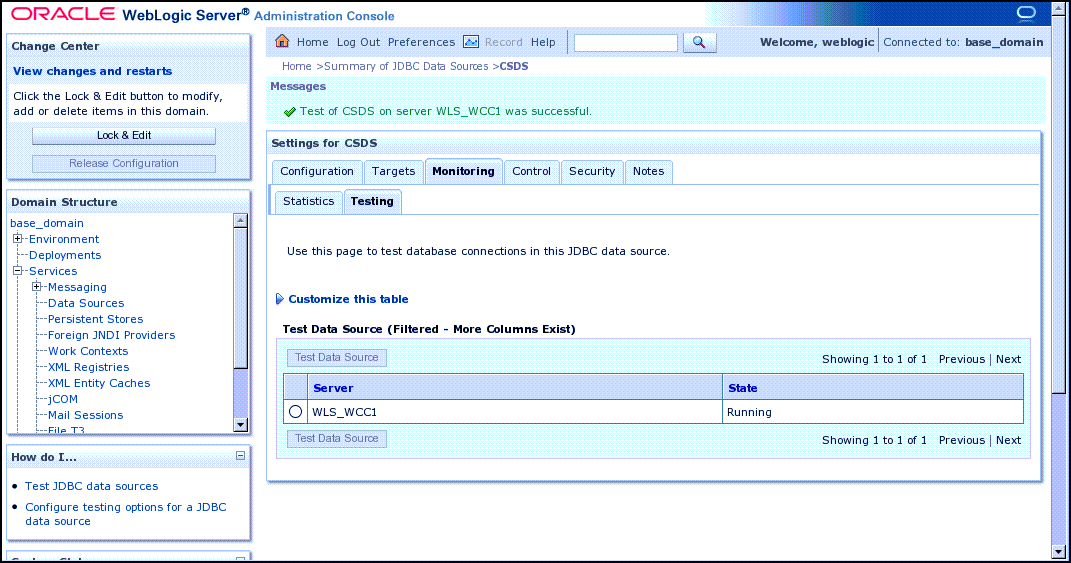
Description of "Figure 10-9 Testing a GridLink Data Source for WebCenter Content"
The test should be successful if the configuration is correct.
-
Repeat the test for every WebLogic Server instance that uses the GridLink data source.
To verify the configuration of ONS for a GridLink data source for WebCenter Content:
-
Log in to the WebLogic Server Administration Console.
-
In the Domain Structure tree, expand Services, then click Data Sources.
-
Click the name of a GridLink data source.
-
Click the Monitoring tab.
-
Click the ONS tab and then the Testing tab (Figure 10-10).
-
Select a server, and click Test ONS.
Figure 10-10 Testing the ONS Configuration for WebCenter Content
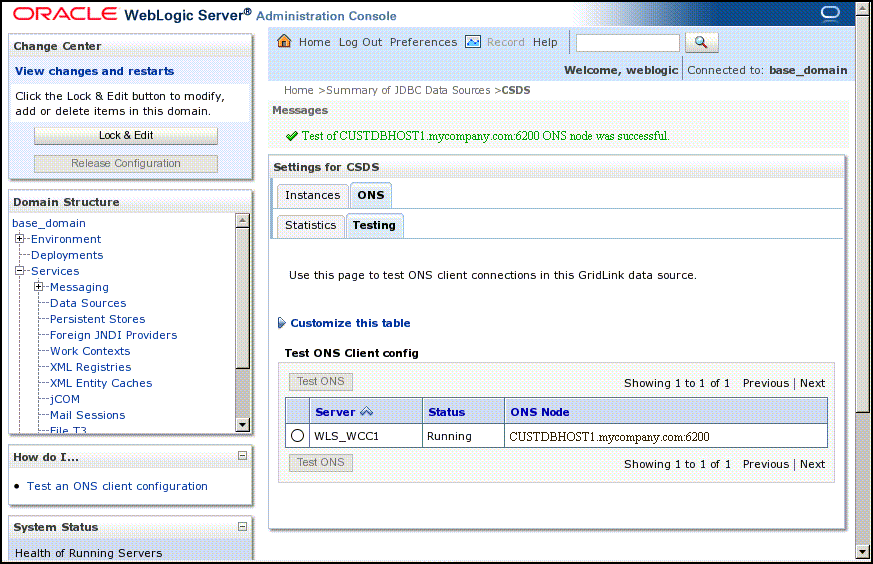
Description of "Figure 10-10 Testing the ONS Configuration for WebCenter Content"
The test should be successful if the configuration is correct. If the ONS test fails, verify that the ONS service is running in the Oracle RAC database nodes:
[orcl@CUSTDBHOST1 ~]$ srvctl status scan_listener SCAN Listener LISTENER_SCAN1 is enabled SCAN listener LISTENER_SCAN1 is running on node CUSTDBHOST1 SCAN Listener LISTENER_SCAN2 is enabled SCAN listener LISTENER_SCAN2 is running on node CUSTDBHOST2 SCAN Listener LISTENER_SCAN3 is enabled SCAN listener LISTENER_SCAN3 is running on node CUSTDBHOST2 [orcl@CUSTDBHOST1 ~]$ srvctl config nodeapps -s ONS exists: Local port 6100, remote port 6200, EM port 2016 [orcl@CUSTDBHOST1 ~]$ srvctl status nodeapps | grep ONS ONS is enabled ONS daemon is running on node: CUSTDBHOST1 ONS daemon is running on node: CUSTDBHOST2
-
Repeat the ONS test for every WebLogic Server instance that uses the GridLink data source.
10.10 Configuring Additional Parameters
Using a text editor, add the following options to each cluster node's MSERVER_HOME/base_domain/ucm/cs/bin/intradoc.cfg file, where the directories specified are on a direct-bus-attached-controlled local disk and not a remote file system, such as a UNIX/Linux mounted NFS or clustered file system (like OCFS2, GFS2, or GPFS):
TraceDirectory=ORACLE_BASE/admin/domain_name/mserver/domain_name/servers/WLS_WCCN/logs EventDirectory=ORACLE_BASE/admin/domain_name/mserver/domain_name/servers/WLS_WCCN/logs/event/ ArchiverDoLocks=true DisableSharedCacheChecking=true
The trailing N should match your nodes' server names, like WLS_WCC1 is WCCHOST1 and WLS_WCC2 is WCCHOST2, and so on.
These changes will take effect after a restart of all WebCenter Content Managed Servers, at the end of the procedure described in Section 10.11, "Configuring Service Retries for Oracle WebCenter Content."
Note:
The directories can reside in any local disk path that you have determined to have enough space to hold the WebCenter Content logs and any trace that you may configure. The preceding paths are a suggestion.
10.11 Configuring Service Retries for Oracle WebCenter Content
The following parameter should be set in the Content Server config.cfg file to enable login retries during an Oracle RAC failover:
ServiceAllowRetry=true
If this value is not set, users will need to manually retry any operation that was in progress when the failover began.
To add the configuration parameter for Oracle WebCenter Content:
-
Go to Oracle WebCenter Content Server at
http://WCCHOST1:16200/cs, and log in using your WebLogic Server administration user name and password. -
Open the Administration page, and then choose Admin Server.
-
On the Content Admin Server page, click General Configuration on the left.
-
On the General Configuration page, add the following parameter in the Additional Configuration Variables box:
ServiceAllowRetry=true
-
Click Save, and restart all WebCenter Content Managed Servers.
Note:
The new parameter is included in the config.cfg file, which is at the following location:
ORACLE_BASE/admin/domain_name/wcc_cluster_name/cs/config/config.cfg
(You can also edit this file directly in a text editor. Do not forget to restart all WebCenter Content Managed Servers.)
10.12 Configuring Oracle HTTP Server for the WLS_WCC Managed Servers
To enable Oracle HTTP Server to route to WCC_Cluster, which contain the WLS_WCC1 and WLS_WCC2 Managed Servers, you must set the WebLogicCluster parameter to the list of nodes in the cluster:
-
For each of the web servers on WEBHOST1 and WEBHOST2, add the following lines to the
ORACLE_INSTANCE/config/OHS/ohs1/moduleconf/wcc_vh.confandORACLE_INSTANCE/config/OHS/ohs2/moduleconf/wcc_vh.conffiles:# UCM <Location /cs> WebLogicCluster WCCHOST1:16200,WCCHOST2:16200 SetHandler weblogic-handler WLCookieName JSESSIONID WLProxySSL ON WLProxySSLPassThrough ON </Location> <Location /adfAuthentication> WebLogicCluster WCCHOST1:16200,WCCHOST2:16200 SetHandler weblogic-handler WLCookieName JSESSIONID WLProxySSL ON WLProxySSLPassThrough ON </Location> <Location /_ocsh> WebLogicCluster WCCHOST1:16200,WCCHOST2:16200 SetHandler weblogic-handler WLCookieName JSESSIONID WLProxySSL ON WLProxySSLPassThrough ON </Location>
-
Restart Oracle HTTP Server on both WEBHOST1 and WEBHOST2:
ORACLE_BASE/admin/instance_name/bin/opmnctl restartproc ias-component=ohsX
For WEBHOST1, use
ohs1forias-componentand for WEBHOST2 useohs2.
10.13 Validating Access Through the Load Balancer
You should verify URLs to ensure that appropriate routing and failover is working from Oracle HTTP Server to WCC_Cluster. To verify the URLs:
-
While WLS_WCC2 is running, stop WLS_WCC1 using the WebLogic Server Administration Console.
-
Access
http://wcc.mycompany.com/csto verify it is functioning properly. -
Start WLS_WCC1 from the WebLogic Server Administration Console.
-
Stop WLS_WCC2 from the WebLogic Server Administration Console.
-
Access
http://wcc.mycompany.com/csto verify it is functioning properly.
10.14 Configuring Node Manager for the WLS_WCC and WLS_IMG Managed Servers
Oracle recommends using host name verification for the communication between Node Manager and the servers in the domain. This requires the use of certificates for the different addresses communicating with the Administration Server and other servers. For more details, see Chapter 13, "Setting Up Node Manager." The procedures in that chapter must be performed twice using the information in the following table.
| Run | Host Name (HOST) | Virtual IP (VIP) | Server Name (WLS_SERVER) |
|---|---|---|---|
|
Run 1 |
WCCHOST1 |
WCCHOST1VHN1* |
WLS_WCC1 |
|
Run 2 |
WCCHOST2 |
WCCHOST2VHN1* |
WLS_WCC2 |
* Optional; required only for Oracle WebCenter Content: Imaging Managed Servers (WLS_IMG).
Notes:
-
Even though the WLS_IMG Managed Servers are not yet configured at this point and are not mandatory for an Oracle WebCenter Content configuration that includes only WebCenter Content, the virtual host names used by Oracle WebCenter Content: Imaging are configured here to provide a one-step configuration process that includes both types of servers. For information about configuring the WLS_IMG Managed Server, see Chapter 11, "Extending the Domain to Include Imaging."
-
For server migration of WLS_IMG1 and WLS_IMG2, you need to associate these servers with virtual host names (WCCHOST1VHN1 and WCCHOST2VHN1). Check that these virtual host names are enabled by DNS or
/etc/hostsresolution in your system and that they map to the appropriate VIPs. For more information, see Section 3.4, "Configuring IPs and Virtual IPs." -
Perform all steps in Chapter 13, "Setting Up Node Manager," except for Section 13.3.5, "Configuring Managed Servers to Use the Custom Keystores," for the WLS_IMG servers. This step can be done after the WLS_IMG servers are added to the domain.
10.15 Backing Up the Installation
After you have verified that the extended domain is working, back up the installation. This is a quick backup for the express purpose of immediate restore in case of problems in the further steps. The backup destination is the local disk. This backup can be discarded once the enterprise deployment setup is complete. At that point, the regular deployment-specific backup and recovery process can be initiated. The Oracle Fusion Middleware Administrator's Guide provides further details. For information on describing the Oracle HTTP Server data that must be backed up and restored, refer to the "Backup and Recovery Recommendations for Oracle HTTP Server" section in that guide. For information on how to recover components, see the "Recovery of Components" and "Recovery After Loss of Component" sections in the guide. For recommendations specific to recovering from the loss of a host, see the "Recovering Oracle HTTP Server to a Different Host" section in the guide. For information about database backup, see the Oracle Database Backup and Recovery User's Guide.
To back up the installation at this point:
-
Back up the web tier on WEBHOST1:
-
Shut down the instance using
opmnctl.ORACLE_BASE/admin/instance_name/bin/opmnctl stopall
-
Back up the Middleware home on the web tier using the following command (as root):
tar -cvpf BACKUP_LOCATION/web.tar MW_HOME
-
Back up the Oracle instance on the web tier using the following command:
tar -cvpf BACKUP_LOCATION/web_instance_name.tar ORACLE_INSTANCE
-
Start the instance using
opmnctl:cd ORACLE_BASE/admin/instance_name/bin opmnctl startall
-
-
Back up the database. This is a full database backup (either hot or cold) using Oracle Recovery Manager (recommended) or operating system tools such as tar for cold backups if possible.
-
Back up the Administration Server and Managed Server domain directory to save your domain configuration. The configuration files all exist in the
ORACLE_BASE/admin/domain_namedirectory. Run the following command on SOAHOST1 to create the backup:tar -cvpf edgdomainback.tar ORACLE_BASE/admin/domain_name
